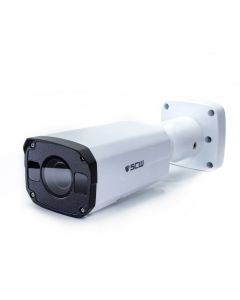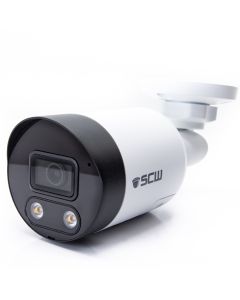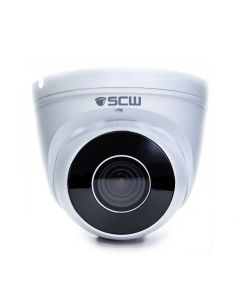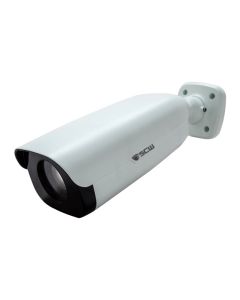This buying guide has four parts:
1. The Skinny
2. Correcting Myths and Misconceptions about Night Vision
3. What camera features should I prioritize if I want better Night Vision?
4. How should I mount and maintain my cameras for the best results?
Part 1: The Skinny:
Lux ratings are supposed to tell you which cameras perform better at night. If you are looking at cameras from a singular manufacturer that's the easiest place to start. Lux ratings, however, have no standardization across brands and are quite subjective. The way SCW tests is probably not the way anyone else tests. There's no good way to compare low light quality from brand to brand.
If you are looking for a camera from SCW and want to know which one does absolutely the best at night, choose ones with our lowest lux ratings like the Knight for short-range, Archer for mid-range, or the Sharpshooter or Spotlight for long-range. The Knight and Sharpshooter have integrated full-spectrum white lights that allow you to take color video at night.
If you are trying to compare low light videography from brand to brand, this guide will help you understand what features result in better low-light photography. A warning: section 3 can be quite technical. Feel free to read as much or as little as you want, but even if you find Section 3, too technical for you, you probably still want to consult the Myths and Best Practices sections of this guide.
Part 2: Correcting Myths and Misconceptions about Night Vision
Myth #1 - Night Vision is invisible
This is a half-myth as Infrared is a light that is invisible to the human eye, but night vision bulbs produce a faint red glow.
Night-vision light is invisible to the human eye, but not to the camera. The reason we can’t see the IR light is that it has a longer wavelength and lower frequency than normal light that is visible to the human eye. The color red has the longest wavelengths of visible light and infraRED means that it has a wavelength even lower than red. A person in a dark room would not be able to see anything other than a faint red glow coming from the infrared LEDs on the camera, but the camera will be able to see and record clearly.
Why does the bulb look red? Because the bulb producing the night-vision light produces some bleed over into the red spectrum. The human eye can pick up the red colors from the bulb. Although it is true that humans cannot see the infrared light when it is projected on an object or person, you can see infrared light bulbs.
Myth #2 - "color infrared camera"
There's no such thing as "color infrared."
The term "color infrared," became popular in the 1970s and 80s. Back then it cost a bit more for high-end color cameras rather than black-and-white cameras. It meant that the camera could do color and infrared. It never meant that the infrared was in color. Nowadays, this is mostly just shady marketing that implies the camera can do something it cannot.
Color

Infrared

Myth #3 - Color Night Vision is better than Infrared Night Vision
Infrared will provide the best image at night, despite claims to the contrary.
While Infrared Night Vision is the best way to see in the dark, everyone wants to have color images and video at night. Although nearly all surveillance cameras have the ability to force color images at night, you don't generally want to do so. Forcing color mode, causes the camera to slow down the shutter speed almost always causes motion blur and digital noise. A still scene without any people or cars in it can look beautiful with color night vision, but people and moving objects look terrible.
You can force color video up until the lux rating of the camera (we'll talk about lux next). For now, all you need to know is that a lower lux rating is better and that it is an indication as to how much light is required for the camera to see an image in color. All SCW cameras have their lux ratings clearly labeled so that you know how well the camera records at night.
Myth #4 - Lux Rating are comparable across brands
Lux is a measurement of the incident light or the light that is falling on an object. A Lux rating is supposed to represent the ability of the camera to absorb light reflecting off an object. That alone makes lux ratings highly subjective. The amount of light reflected changes based on the color, shape, and environment of what you are filming.
Lux ratings are subjective. Each brand uses its own way to calculate it.
We have an entire guide devoted to talking about the subjective nature of Lux Ratings, but there's the low down:
1. Lux Ratings tell you how a brand thinks about their lineup of cameras, but you can't compare Lux from brand to brand because there's no standardized way to measure Lux, nor is there a standardized success metric.
2. Lux is kind of measuring the wrong thing anyway since it measures the light hitting an object, whereas the camera captures the light reflected off an object.
3. This makes it sound like Lux ratings are worthless, but they aren't. Brands almost always use the same way of calculating lux across their product lines.
Lux Ratings are great at evaluating quality differences within a single Brand's offering. They are bad at evaluating one brand against another.
[Buying based on Lux Ratings] rewards the most unscrupulous vendors who realize that they are rarely if ever, called on their specs.
-IPVM
Part 3. Buying Guide - What makes a camera good at low light?
There are several ways to increase the amount of light that is absorbed by a camera sensor. Two of those ways have pretty large drawbacks. Let's look at them first.
Part 3A - Ways to Make Better Night Vision That Probably Aren't Worth It
1. Aperture (F Stop) - a pretty big tradeoff
In any camera (CCTV or regular cameras), the aperture funnels light into the lens. The larger the aperture, the more light enters the lens. It may seem backward, but a smaller f-stop means a larger aperture, while a larger f-stop means a smaller aperture.
A larger aperture (and smaller F-Stop) means more light can enter the lens, but the size of the aperture also directly impacts the depth of field--what area of the image appears sharp and clear. A large f-number/smaller aperture will bring all foreground and background objects in focus. Someone ten feet from the camera and fifty feet from the camera will still look clear and in focus (but obviously further away). While a small f-number/larger aperture will isolate the foreground from the background by making the foreground objects sharp and the background blurry. You can see this difference in these images.
We list the F Stop on all our cameras.
Because you don't know if someone will be near or far, large changes in aperture is not a good way to solve the issue with low light surveillance.
What if you could change the aperture based on what you are looking at?
A P-Iris lets you do just that. A P-Iris is the next level up from a DC-iris lens. A DC-Iris exists to continuously adjust the flow of light through the lens, while a P-Iris exists both adjust to lighting conditions and ensure that the camera is using the best possible aperture (f-stop) for what it is filming. This means fewer optical errors, and the best contrast, resolution, and depth of field the camera can offer. Our highest-end cameras in our 4K line - The Gladiator and The Archer have P-Iris's.
A word of caution on ultra-high-resolution cameras: you'll notice that our 4K line's lux rating is near the bottom of the list in terms of the lux rating. Bleeding edge technology is usually like this. The sensors are so new that they haven't fully developed yet in terms of low light performance. You'll notice that our cameras with the best lux rating have 2MP sensors, this is because newer, higher-resolution sensors, like 4MP or 4K, haven't had enough time to develop fully. They are still early in their product development cycle and haven't developed as fully as the 2MP line.
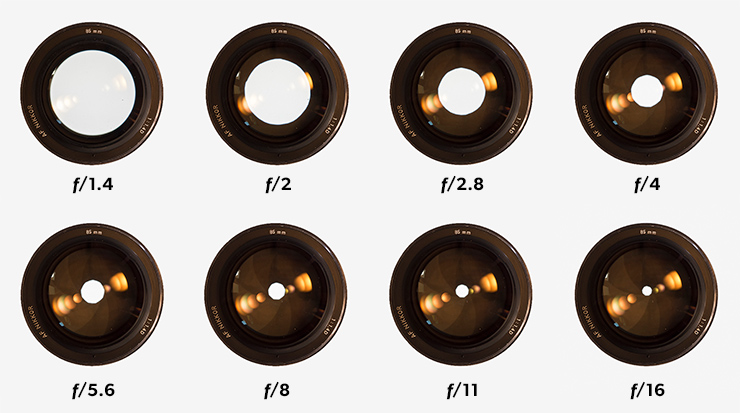

2. Adjustable Shutter Speed--a tradeoff under certain circumstances
Every camera (including security, movie, and regular cameras) operates the same way: a shutter opens which allows light to be absorbed by the image sensor. Then the shutter closes allowing it to take the next picture. When recording video, these pictures are taken so quickly that your brain perceives them as fluid, but a movie camera, camcorder, or security camera are all just taking rapid pictures.
The shutter in a camera controls how long the camera requires to take a picture, but faster doesn't mean better. The faster that a camera shutter opens and closes, the more likely that you will get a clear, blur-free image. The longer that the shutter is open, the more light you let in, and the better your image will be in low light. Shutters that are open for an extremely long time allow you to take color pictures at night/twilight without having to switch to infrared mode, but will cause motion blur.
All our cameras have adjustable shutter speeds, usually in a range between 1/30s to 1/100,000 of a second.
Slowing the shutter speed can be a good way to get better low light results, but large shutter speed changes can only work on slow-moving objects.

Part 3B - Ways to Make Better Night Vision That Are Worth It
Larger Image Sensors
This is the preferred way to solve the issue of security cameras. A 1/2 inch image sensor is going to let in more light than a 1/3 inch image sensor without really any drawbacks but one--price.
Sensors are typically the most expensive part of a camera to manufacture, and the larger you go the pricier the camera gets.
You get what you pay for. We have all our image sensor sizes listed on our website and we're happy that we tend to have larger sensors than our competitors (at similar levels of product).
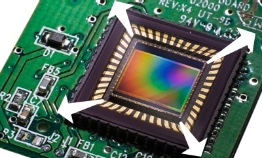
Car Grade LEDs
Many IP cameras include low-quality infrared bulbs that fail over time. All Our Admiral Line cameras have Car Grade LEDs, and you should expect the same sort of longevity from them as the headlights in your car.
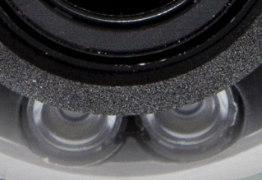
Anti-Reflective Glass
Anti-Reflective Glass allows better light transmission vs standard glass. Standard glass cameras often come with a foam ring around the lens to prevent infrared light from bouncing back off the glass and entering the lens. This bounce-back can cause extreme differences in infrared lighting, which makes some items too bright and others too washed out if the ring is loose, ripped, or removed. Anti-Reflective Glass prevents this issue. Also, people have a tendency to accidentally destroy, damage, throw away or lose these foam rings. Anti-Reflective Glass reduces maintenance and user error.
Anti-Reflective Glass is available on our Admiral line Bullet Security Cameras, turret, and PTZ models. It is not available on our glass dome models because anti-reflective glass doesn't work with that much curvature.
If you care about Night Vision, go with a Bullet or Turret instead of a Dome Camera.
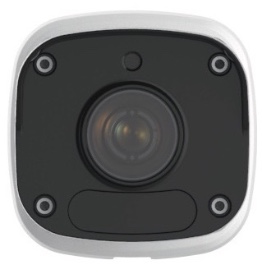
WDR can help, kind of (Wide Dynamic Range)
Cameras with WDR take two photos at once--one at a higher light setting and another at a lower setting. Then the camera "stitches" them together into one image. WDR comes as either a True WDR or Digital WDR. Digital WDR does this work with post-processing algorithms, as seen in these images.
Almost all our cameras have either Digital or True Wide Dynamic Range.
Although WDR does not exactly deal with night videography, it certainly helps in situations where you have uneven lighting, which is usually the case with low lux photography. Streetlights, floodlights, and night lights, all provide much stronger light in one area than others.
We have a very similar guide to this one on Buying Guide and Best Practices: Seeing in shadows.

Cheat a little; Get a Camera with a White, Natural Light
One of the most innovative ways to beat low-quality infrared video is to use a light, and we have two cameras with that exact feature.
Our Knight and Spotlight cameras have Full Spectrum (White) Lights.
The Knight has an integrated PIR motion sensor that turns on a natural, full-spectrum motion light when movement is detected close to the camera. This allows you to take a color photo at night or in other conditions when movement is detected within fifteen feet of the camera. There are sensitivity controls for the amount of motion necessary to trigger the PIR sensor.
The Spotlight has an integrated natural, full-spectrum light that is rated at 100 feet.
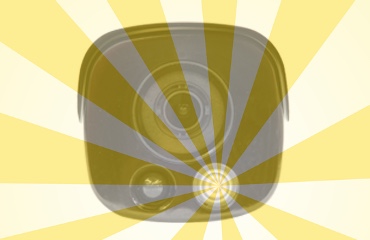
Part 4 - How should I mount and maintain my cameras for the best results?
Feel free to try Color Mode at Night but Don't Expect a Miracle
How the image will look on a camera at night with the IR turned off will depend on the ambient light in and around the area and what the lux rating is on the camera itself. The lower the lux the better the low-light image that camera will have. (If the image is too dark this is an indication it is too dark for the camera’s lux level and you will need to use IR)
Works great when there's not a lot of movement
Doesn't work so well when there is movement
Remember to Clean your Cameras; Dirty Dome/Lenses cause issues with IR
You'll notice that we carry fewer glass dome cameras and more turret style dome cameras than many of our competitors. This is intentional.
When you have a dirty dome or lens the daytime image can look great but at night a blurred image or IR bounce back from something on the dome is not uncommon. Clean your lens or dome with a microfiber cloth and distilled water for the best results.
Clean Lens

Dust on Lens

Fingerprint on Lens

Beware of IR Bounce Back:
There will be cases when installing cameras an object in the foreground reflects most if not all of the IR at night. The image will look great in the day but at night you may see a wall or another object that is very bright and the background is dark. You can normally solve this by adjusting the camera away from the said wall or object.

Don't mount an Infrared Light facing a Window
Infrared Light is incredibly reflective. You cannot place an IR camera inside a window looking out and expect to get a good video. Aiming a camera at a window causes the infrared light to bounce off the window and look like a flashlight is being pointed at the camera.

Go With The Grain When Mounting Cameras with Motion/Flood Lights
Just like how a flashlight works a whole lot better pointing it away from you, you should always mount the cameras looking the same direction your existing lights are pointed. Never mount a camera looking at a floodlight/motion light. When it is very dark, your eyes will hurt if you suddenly shine a flashlight into your own eyes. You can burn out the image sensor in a camera by shining unexpected light directly into it. When using an external light source, like a motion light or a floodlight, you should always try to mount your camera in front of your light source and have them angled in the same direction.
Infrared Light and License plates
License plates are designed to reflect light to make them easier to be seen by police officers' headlights. This has the unintended effect of making them harder to see with infrared cameras. Because infrared light is more reflective than white light, the images often look overexposed. We have a whole guide just like this one on choosing the best camera for license plates.
Feel free to try Color Mode at Night but Don't Expect a Miracle
How the image will look on a camera at night with the IR turned off will depend on the ambient light in and around the area and what the lux rating is on the camera itself. The lower the lux the better the low-light image that camera will have. (If the image is too dark this is an indication it is too dark for the camera’s lux level and you will need to use IR)
Works great when there's not a lot of movement
Doesn't work so well when there is movement
Remember to Clean your Cameras; Dirty Dome/Lenses cause issues with IR
You'll notice that we carry fewer glass dome cameras and more turret style dome cameras than many of our competitors. This is intentional.
When you have a dirty dome or lens the daytime image can look great but at night a blurred image or IR bounce back from something on the dome is not uncommon. Clean your lens or dome with a microfiber cloth and distilled water for the best results.
Clean Lens

Dust on Lens

Fingerprint on Lens

Beware of IR Bounce Back:
There will be cases when installing cameras an object in the foreground reflects most if not all of the IR at night. The image will look great in the day but at night you may see a wall or another object that is very bright and the background is dark. You can normally solve this by adjusting the camera away from the said wall or object.

Don't mount an Infrared Light facing a Window
Infrared Light is incredibly reflective. You cannot place an IR camera inside a window looking out and expect to get a good video. Aiming a camera at a window causes the infrared light to bounce off the window and look like a flashlight is being pointed at the camera.

Go With The Grain When Mounting Cameras with Motion/Flood Lights
Just like how a flashlight works a whole lot better pointing it away from you, you should always mount the cameras looking the same direction your existing lights are pointed. Never mount a camera looking at a floodlight/motion light. When it is very dark, your eyes will hurt if you suddenly shine a flashlight into your own eyes. You can burn out the image sensor in a camera by shining unexpected light directly into it. When using an external light source, like a motion light or a floodlight, you should always try to mount your camera in front of your light source and have them angled in the same direction.
Infrared Light and License plates
License plates are designed to reflect light to make them easier to be seen by police officers' headlights. This has the unintended effect of making them harder to see with infrared cameras. Because infrared light is more reflective than white light, the images often look overexposed. We have a whole guide just like this one on choosing the best camera for license plates.

Lean on the experts
We'd be happy to work up a custom quote or take your floorplan and create a security coverage map.
Get aCustom Quote




